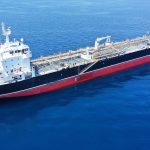

Navigating the Waves: Unveiling the Vital Role of AHTS Vessels in Offshore Operations
Introduction
AHTS vessels, also known as Anchor Handling Tug Supply vessels, play a vital role in offshore operations. These specialized vessels are designed to handle anchors for oil rigs, tow them to location, and secure them in place. However, their functions extend beyond anchor handling to include towing assistance and supply duties. In this article, we will delve into the essential functions and capabilities of AHTS vessels in supporting offshore activities.
AHTS vessels are crucial in facilitating safe and efficient offshore operations. With their robust winch systems and versatile design, they are well-equipped to handle the demands of the offshore environment. Let’s delve deeper into understanding the features and capabilities of these remarkable vessels.
Understanding AHTS Vessels
AHTS vessels, are integral to offshore operations due to their unique design and versatile capabilities. These vessels are equipped with robust winch systems that play a crucial role in anchor handling operations. The design aspects of AHTS vessels are carefully tailored to meet the specific demands of offshore tasks, ensuring they can operate effectively in harsh marine environments.
Key Features and Functions
1. Winch System for Anchor Handling
The winch system is a key feature of AHTS vessels, enabling them to handle anchors for oil rigs and provide towing assistance during various operations. This component is essential for securing rigs in place and facilitating safe and efficient maneuvers at sea.
2. Multi-Utility Nature
Additionally, AHTS vessels are characterized by their multi-utility nature, allowing them to perform diverse functions effectively:
- Supply Transports: Benefiting from large Deck Space on its main deck, AHTS vessels can transport essential containers, material and equipment to offshore installations, supporting the smooth running of operations.
- Liquid Cargo Transport: AHTS vessels are Equiped with tanks that can help supply Fresh water, Fuel Oil, Cement, liquid mud, and potable water that are all essential for offshore platform oil drill operations.
- Emergency Response and Rescue Vessels (ERRVs): In case of emergencies or accidents, AHTS vessels can be deployed quickly as rescue units, providing aid and evacuation support.
- Specialized Services: They can also offer specialized services such as ROV support for subsea inspections, contributing to maintenance and repair activities.
Importance in Offshore Operations
The multi-utility aspect of AHTS vessels enhances their value in offshore operations, as they can adapt to a wide range of tasks and contribute significantly to the overall efficiency and safety of marine activities.
Key Functions of AHTS Vessels in Offshore Operations
AHTS vessels play a pivotal role in supporting offshore activities through their multifaceted functions. The primary functions of AHTS vessels encompass anchor handling maneuvers, towing assistance, and supply duties to offshore platforms.
Anchor Handling Maneuvers
AHTS vessels are specifically designed to handle anchors for oil rigs and tow them to their designated locations. This critical function ensures the secure placement of rigs in the offshore environment. The robust winch system equipped on these vessels is instrumental in effectively managing anchor handling operations, providing the necessary power and control required for this task.
Towing Assistance
AHTS vessels contribute significantly to towing operations, particularly during tanker loading and deepwater anchor handling. Their powerful bollard pull and specialized winches enable them to tow threatening objects away from offshore installations, enhancing safety and operational efficiency.
Supply Duties
These vessels serve as essential transport links between land bases and drilling sites, facilitating the transportation of vital supplies and equipment required for offshore operations. Their ability to navigate challenging marine conditions makes them indispensable for ensuring a continuous and reliable supply chain to offshore platforms.
By excelling in these key functions, AHTS vessels form the backbone of offshore operations, demonstrating their adaptability and reliability in meeting the diverse demands of the industry.
Supporting Roles: Towing, ROV Services, and More
AHTS vessels not only excel in anchor handling and supplying offshore platforms, but they also play a crucial role in other supporting operations. Let’s explore some of these additional functions:
1. Towing Operations
AHTS vessels are equipped with powerful engines and robust winch systems, making them ideal for towing operations. They can assist in towing large structures such as barges, rigs, or even damaged vessels to safety. The high bollard pull of AHTS vessels enables them to handle heavy loads efficiently, ensuring the smooth and safe movement of objects in offshore environments.
2. ROV Services
AHTS vessels often provide specialized services such as ROV support for subsea inspections. Remotely Operated Vehicles (ROVs) are unmanned underwater vehicles equipped with cameras and sensors to conduct inspections and surveys at great depths. AHTS vessels serve as a platform for launching and retrieving ROVs, allowing them to perform critical tasks such as pipeline inspections, underwater repairs, or environmental assessments.
3. Emergency Response and Rescue
Due to their powerful engines and maneuverability, AHTS vessels are frequently designated as Emergency Response and Rescue Vessels (ERRVs). In times of emergencies or accidents, these vessels can quickly reach the affected area and provide immediate assistance to distressed ships or offshore installations. Their ability to handle anchor handling operations also makes them well-suited for rescue purposes.
4. Supply Duties
Apart from anchor handling and towing assistance, AHTS vessels continue to fulfill their traditional role as supply transports. They ensure the timely delivery of essential equipment, provisions, fuel, water, and personnel between onshore bases and offshore platforms. This logistical support is vital for the uninterrupted operation of oil rigs or other offshore installations.
Through their diverse range of functions such as towing assistance, ROV services, emergency response, and supply duties, AHTS vessels prove their versatility and indispensability in offshore operations. Their ability to adapt to various tasks showcases their value in supporting a wide range of activities at sea.
The Versatility of AHTS Vessels: Adapting to Changing Industry Needs
AHTS vessels have continually adapted to meet the evolving demands of the offshore industry, demonstrating an impressive versatility that extends beyond traditional functions. In response to shifting industry trends, these vessels have expanded their capabilities to support renewable energy projects, reflecting their pivotal role in facilitating the transition towards sustainable offshore operations.
Evolution to Support Renewable Energy Projects
AHTS vessels have demonstrated their adaptability by actively participating in renewable energy ventures, such as offshore wind farm installations and maintenance. Their robust capabilities make them well-suited for tasks like transporting and installing wind turbine components, contributing to the growth of clean energy initiatives.
Multi-Functional Capabilities
Beyond their historical role in oil and gas operations, AHTS vessels have diversified their functions to accommodate the changing landscape of offshore activities. This adaptability underscores their significance as versatile assets that can pivot to address emerging industry needs while maintaining operational efficiency.
Dynamic Response to Industry Shifts
The ability of AHTS vessels to evolve in response to industry dynamics highlights their resilience and relevance in a rapidly changing landscape. As new challenges and opportunities emerge within the offshore sector, these vessels continue to play a crucial role in addressing diverse operational requirements.
The ongoing adaptability of AHTS vessels reflects their enduring value as indispensable assets within the offshore industry, positioning them as key enablers of progress amidst industry evolution.
Meeting Challenges Head-On: AHTS Vessels in Harsh Environments
AHTS vessels are designed and equipped to operate effectively in harsh offshore environments, ensuring the continuity of critical operations. These vessels face numerous challenges while carrying out their functions, including extreme weather conditions, rough seas, and remote locations. However, they are specifically built to overcome these challenges and meet the demands of offshore operations.
Here are some key points to consider:
Robust Construction
AHTS vessels are constructed with robust hulls and strengthened structures to withstand the harsh conditions of the open sea. The materials used in their construction are carefully selected for their durability and resistance to corrosion.
Dynamic Positioning Systems
AHTS vessels are equipped with advanced dynamic positioning (DP) systems that enable them to maintain precise positions even in strong currents or high winds. These DP systems use a combination of GPS, thrusters, and sensors to ensure optimal vessel positioning during anchor handling maneuvers or supply operations.
Powerful Propulsion
AHTS vessels are equipped with powerful engines and propulsion systems that allow them to navigate through rough seas and maintain stability during towing or anchor handling operations. The high bollard pull of these vessels ensures sufficient pulling power to handle heavy anchors or tow large structures.
External Fire Fighting System
Majority of AHTS vessels are also equipped with external firefighting system (FIFI 1) in excess of 2400 cubmtr/hr that enables fighting of Fire on board other vessels or offshore installations.
Anti Pollution Oil Recovery systems
AHTS vessels are typically equipped with oil recovery systems to help recover accidental oil spillage during offshore operations.
Safety Measures
Safety is paramount in offshore operations, and AHTS vessels are equipped with state-of-the-art safety features to protect both crew members and the environment. These include fire detection and suppression systems, life-saving equipment, and emergency response plans.
Specialized Equipment
As mentioned, AHTS vessels are fitted with specialized equipment such as winches, cranes, and deck space for handling anchors, towing equipment, and cargo. These features enable efficient anchor handling maneuvers, towing operations, and transportation of essential supplies to offshore platforms.
By utilizing their robust construction, advanced technology, powerful propulsion systems, and specialized equipment, AHTS vessels are able to navigate and operate effectively in even the most challenging offshore environments. They play a crucial role in ensuring the continuity of critical operations and supporting the offshore industry’s needs.
In addition to their design and equipment, AHTS vessels also employ experienced and skilled crews who are trained to handle the unique challenges of operating in harsh offshore environments. These crews undergo rigorous training programs that include safety protocols, emergency response procedures, and specialized skills for anchor handling, towing, and supply duties.
Furthermore, AHTS vessels often have backup systems for essential equipment to minimize downtime in case of failures or emergencies. This redundancy ensures that critical operations can continue without interruption, even in challenging conditions.
The adaptability of AHTS vessels extends to their ability to operate in various regions around the world. Whether it is the icy waters of the Arctic or the turbulent seas of the North Sea, these vessels have proven their capability to handle extreme conditions and deliver reliable support.
The Future Outlook for AHTS Vessels
As the offshore industry continues to evolve, AHTS vessels are expected to play an increasingly significant role in supporting various operations. Here are some key points to consider regarding the future outlook for AHTS vessels:
1. Advancements in Technology
AHTS vessel technology is likely to witness significant advancements in the coming years. These advancements may include:
- Improved propulsion systems
- Advanced winch designs
- Enhanced navigation and communication systems
- The integration of automation and digitalization technologies
2. Increased Efficiency and Sustainability
With a growing focus on efficiency and sustainability, AHTS vessels of the future may incorporate innovative features such as:
- Hybrid or electric propulsion systems to reduce fuel consumption and emissions
- Advancements in hull design and materials to improve fuel efficiency and environmental performance
3. Diversification of Services
To cater to the changing needs of the offshore industry, AHTS vessels are expected to diversify their range of services. This may involve expanding capabilities beyond anchor handling and towing assistance to include specialized services like:
- Subsea construction support
- Well intervention
- Renewable energy project support
4. Integration of Remote Technologies
Remote technologies such as autonomous vessels and remotely operated vehicles (ROVs) are likely to be more and more integrated into AHTS vessels, enabling more efficient and safer operations. These technologies can:
- Enhance operational capabilities
- Reduce risks associated with human intervention
- Enable remote monitoring and control of critical systems
5. Adapting to Renewable Energy Projects
As the global energy landscape shifts towards renewable sources, AHTS vessels have the potential to play a crucial role in supporting offshore wind farms and other renewable energy projects. Their robust capabilities for anchor handling, supply duties, and towing assistance make them well-suited for these endeavors.
6. Collaboration with Other Industry Players
The future of AHTS vessels may involve closer collaboration with other industry players, such as:
- Offshore wind farm developers
- Oil and gas operators
- Technology providers
This collaboration can lead to the development of specialized vessel designs, optimized operational strategies, and innovative solutions tailored to specific offshore projects.
The future of AHTS vessels looks promising, with advancements in technology, increased efficiency and sustainability, diversification of services, integration of remote technologies, adaptation to renewable energy projects, and collaboration with other industry players. These developments will further enhance the capabilities and versatility of AHTS vessels in supporting offshore operations across various sectors.
Chartering AHTS Vessels: Optimizing Offshore Logistics for Success
In the realm of offshore logistics, AHTS vessels, also known as Anchor Handling Tug Supply Vessels, stand as indispensable assets. Whether it’s supplying vital cargo to offshore platforms or executing intricate anchor handling maneuvers, these vessels are the linchpin of efficient operations at sea. For companies seeking to harness the power of these versatile vessels, chartering options provide a flexible solution. From AHTs for charter to specialized anchor handling tugs for charter, the world of chartering opens up avenues for businesses to access precisely the vessels they need, precisely when they need them. Chartering offers a strategic advantage, allowing companies to navigate the complex waters of offshore endeavors with tailored solutions, ensuring smooth sailing towards success. Charterers that are new to the field of offshore can benefit a lot from working with shipbrokers who are affiliated with offshore industry.
Conclusion
As we wrap up this exploration of AHTS vessels in offshore operations, it is clear that these vessels play an essential role in enabling safe and efficient activities such as the installation and maintenance of oil rigs. Their ability to handle anchors, provide towing assistance, and supply goods and equipment is crucial for the smooth running of offshore projects.
Here are the key points to remember:
- Versatile and Indispensable: AHTS vessels are essential for anchor handling, towing assistance, and supply duties in offshore operations. They are like multi-purpose tools that can perform various tasks as needed.
- Supporting Critical Operations: These vessels also contribute to towing operations and may offer specialized services such as ROV support for subsea inspections. This support is vital for ensuring the integrity and safety of underwater structures.
- Adapting to Changing Needs: AHTS vessels have evolved to meet the changing demands of the industry, including supporting renewable energy projects like wind farms. This adaptability is key in staying relevant and meeting future challenges.
- Built for Tough Conditions: They are designed and equipped to operate effectively in harsh offshore environments, ensuring the continuity of critical operations even in challenging weather conditions.
Related posts


LNG Tanker Valuation: What Influences the Sale Price?

Buy and Sell Offshore Vessels






